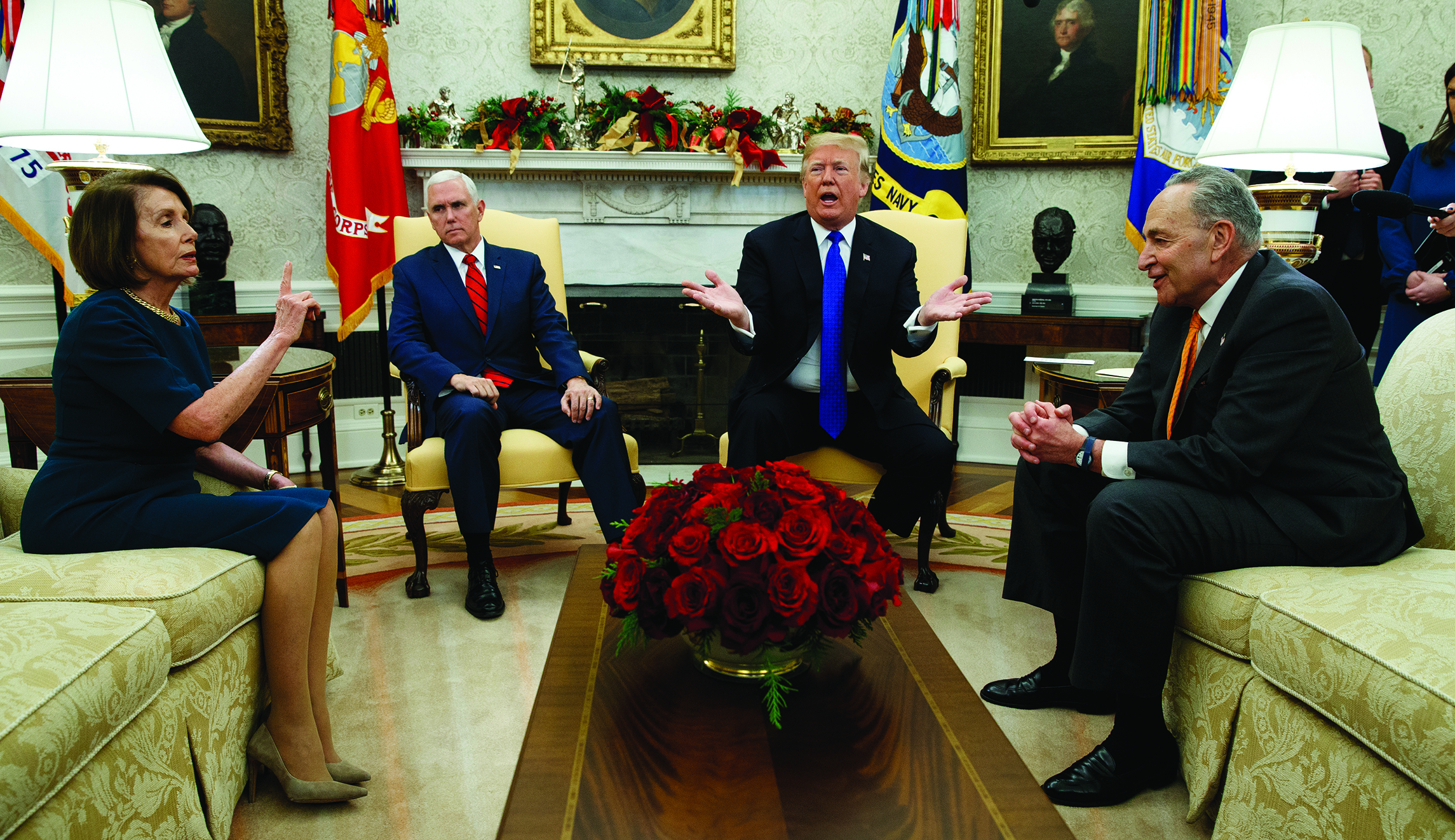Donald Trump officially announced his candidacy for president on June 16, 2015. It was the first time he promised that, if elected, he’d see to it that the United States built a wall along its southern border. Over the next 18 months, the wall would define his candidacy. Two years into his first term, it defines his presidency still.
A fight over congressional funding for the wall has triggered the longest government shutdown in the nation’s history. But the $5.7 billion price tag isn’t really the core of the dispute. No, the fight became intractable because the wall has become a conceptual holy grail for the president and a stop-it-at-all-costs bugbear for Democratic leaders. It is likely to remain so for long after the shutdown ends and government work resumes.
While it began in December, when the GOP controlled both chambers of Congress, the Democrats have dug in now that they control the House, and Speaker Nancy Pelosi, D-Calif., has shown no willingness to make her first act a concession of this size to a president that she and her party detest. Trump, who infamously said he’d own the shutdown if he didn’t get the wall funding he demands, now has little wiggle room to negotiate.
For all that Trump promised as a candidate, nothing stood out more than his pledge to crack down on illegal immigration. Central to that vow was the proposed wall along the Mexico border. Throughout the GOP primaries and into the 2016 general election, candidate Trump knew he could stir up the crowds at his rallies by invoking the wall and his contention that Mexico would bear the costs of building it.
While Trump’s base of support is willing to overlook that Mexico is, in fact, not paying for the wall, they still want the president to keep his promise to build it — even if it means they and other taxpayers foot the bill. Indeed, a GoFundMe for the wall, organized by one of the president’s supporters, reached $20 million in donations. The goal, however, was $1 billion, so the fundraiser was closed and all donors were promised refunds.
This is where Trump’s outsider status really comes into sharp relief. A broad swath of voters had become convinced that party politicians, even governors who always fancy themselves as “outsiders,” had “betrayed” constituents by focusing more on keeping power than on doing what they promised in their campaigns. Trump’s promise to “drain the swamp” as well as “build the wall” helped him to run roughshod over seasoned political veterans in the GOP primary and gain just enough voters in the previously blue states of Wisconsin, Michigan, and Pennsylvania to deliver an electoral victory over Democrat Hillary Clinton.
The expectation that he will keep his promise leaves him little room in his negotiations with Pelosi and Senate Minority Leader Chuck Schumer, D-N.Y. Their leverage over him will probably increase over time, since part of Trump’s sense of urgency stems from his party’s loss of power in the House for the last two years before his bid for re-election. The president cannot afford to lose support from his base, and he cannot wait Pelosi out.

The president finds himself in a similar situation to that of President George H.W. Bush nearly 30 years ago. On Nov. 5, 1990, Bush signed the Omnibus Budget Reconciliation Act and, in doing so, broke one of the most famous promises in political history. Two years earlier, he had delivered a stirring speech at the Republican National Convention, promising that, if elected, he would adamantly refuse to raise taxes. Bush and his team had been concerned about a lack of enthusiasm for him in the conservative wing of the party. Their solution was to make a pledge in the candidate’s convention acceptance speech. Written by Peggy Noonan, Bush said, “I’m the one who will not raise taxes. My opponent now says he’ll raise them as a last resort, or a third resort. But when a politician talks like that, you know that’s one resort he’ll be checking into. My opponent won’t rule out raising taxes. But I will. And the Congress will push me to raise taxes, and I’ll say no. And they’ll push, and I’ll say no, and they’ll push again, and I’ll say, to them, ‘Read my lips: no new taxes.’ ”
When Bush signed the budget bill two years later, the same conservative wing he had reassured with his pledge was outraged. Despite a political reprieve during the Gulf War, the president’s broken promise continued to plague him until he went down in defeat at the hands of Democrat Bill Clinton. Fellow Republican Pat Buchanan used it against him during the 1992 New Hampshire primary, and Democrat Al Gore used it as a comeback line against then-Vice President Dan Quayle in the vice presidential debate. It’s difficult to quantify to what extent it hurt Bush with voters, but it’s also difficult to think of anything that disenchanted the party base more.
There wasn’t 24-hour cable news, the Internet, and social media to contend with in 1990, so the current media maelstrom makes things a lot harder for Trump than they were for Bush. Any deal to end the shutdown that allocates less money than he insists is necessary to secure the border will allow Pelosi and Schumer to declare victory, angering Trump’s base and perhaps turning them away from their hero. Those supporters would see the move as capitulation by a president who promised to fight for them. Trump cannot afford to have supporters decide that instead of draining the swamp, he got swallowed by it.

Yet Pelosi and Schumer also face political pressure, having to balance the interests of the far left with those of many new freshman Democrats elected in districts won by Trump in 2016. It used to be difficult to imagine Pelosi getting outflanked on her left, but now upstart freshman Democrats such as Alexandria Ocasio-Cortez, D-N.Y., and Rashida Tlaib, D-Mich., are part of a growing chorus of militant progressives willing to buck leadership in much the same way GOP House Freedom Caucus members did when Republicans retook control of the House in the 2010 midterm elections.
Legislators such as Ocasio-Cortez not only oppose any funding for a wall but demand the abolition or defunding of Immigration and Customs Enforcement. Tlaib drew raucous applause when she crudely described President Trump as a “motherfucker” and declared she’d seek his impeachment. On the other side are freshman House members such as Rep. Abigail Spanberger, D-Va., and Rep. Colin Allred, D-Texas, who beat Republican incumbents representing suburban districts. They’ve expressed concern about the length of the shutdown and their leaders’ unwillingness to say what kind of border security, if any, they are willing to support.
It’s a problem for Pelosi. Does she want a revolt from the more left-wing faction in the caucus or to put members in swing districts in jeopardy by refusing to compromise with the president?
[Related: ‘Gang of 20’ emerges in Senate to push for a border wall deal]
The puzzle for Pelosi and Schumer is how to “win” the shutdown without seeding political problems for Democrats, especially those in swing or border districts, in the next election. So far, they’ve stumbled. Their arguments against the $5.7 billion meander all over the place. Today they say walls are “ineffective,” and the next day they say they’re “immoral.”

The truth is, of course, that walls do work, which is why people build them all over the world. Gated communities have walls. Prisons have high fences and barbed wire. Airports, nuclear power plants, and other facilities with national security implications have fences and secure perimeters. It may be that such effectiveness isn’t scalable to something the size of the southern border. But that’s not the same as saying baldly that walls don’t work, which rings hollow to most.
The people at the sharp end of immigration policy, Border Patrol agents, side with the president. In a recent interview with NPR, Terence Shigg, a 22-year veteran of the Border Patrol, said, when asked if walls work, “Yes, that is my position. And the wording changes from walls to barriers to fencing. And I think barriers work, and that’s been proven, especially here in San Diego. You can come here, and you can see the places that are more secure due to the fact that we have barriers here. So I agree with that statement, and I think most Border Patrol agents know that that is a fact: that they do help and that they do work.”
The moral argument posited by Democrats comes off as nakedly opportunistic and self-righteous. Schumer voted for the Secure Fence Act of 2006, as did then-Sens. Hillary Clinton, Barack Obama, and Joe Biden. When confronted with this, Democrats resort to pedantic distinctions between fences and walls. Democratic leaders in safe seats may think they can play this semantic game forever, but eventually they’ll have to find better arguments or endanger the members of their own caucus who support border barriers.
Still, Trump might be his own worst enemy. He co-wrote The Art of The Deal, but on this issue, he riles up people who already support him and tries ineffectively to intimidate others into going along with him. Pelosi and Schumer are political pros and not cowed by such antics.

Trump blundered impetuously into the mess he now finds himself in. In his first two years in office, he had Republican majorities in both chambers, although not big enough to overcome filibusters in the Senate. He had several opportunities to secure money for the wall. When House Republicans put together the tax reform package, signed by Trump on Dec. 22, then-Speaker Paul Ryan and Ways and Means Committee Chairman Kevin Brady included a border adjustment tax. It fit Trump’s worldview, with Ryan claiming it would create incentives for companies to produce more goods in the United States. But the president’s former economic adviser, Gary Cohn, and Treasury Secretary Steven Mnuchin opposed it, and Trump went along with them in the end, forcing Ryan and Brady to back down.
In February 2018, Republican Sen. Mike Rounds of South Dakota and independent Sen. Angus King of Maine put together compromise legislation. Trump would get $25 billion, which was his initial request for the wall, and the bill would also provide a path to citizenship for so-called “Dreamers” brought to the country illegally as children. Instead of negotiating, Trump blasted the bill as “amnesty” and threatened to veto it. It never advanced in the Senate, failing to reach the 60-vote threshold required for a floor vote.
A year later, the government found itself shut down, with Trump facing a Democratic majority in the House. Neither side is going to escape this easily. Trump doesn’t have his wall. Dreamers are in limbo. The immigration system is broken.
That $5.7 billion is just 0.11 percent of the total federal budget. Then again, this fight was never really about the money.

